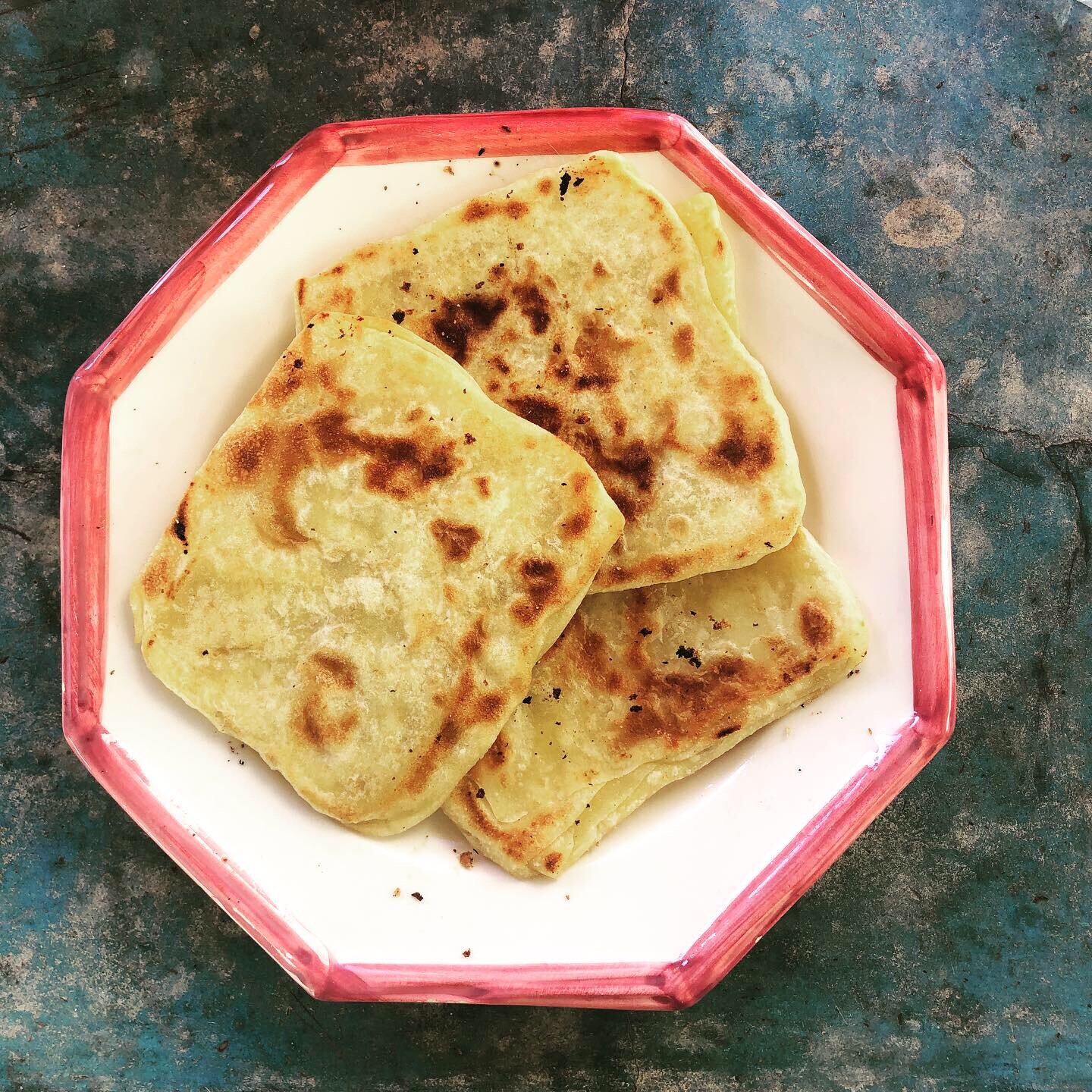Morocco has received an increasing amount of attention in the past few years as a trendsetter in fashion and design, blending traditional craft with modern looks. Did you know that Morocco is also a leader in cuisine? Moroccan food is layered with culinary influences ranging from sub-Saharan spices to Mediterranean staples like olive oil and citrus, to the finesse of the French patisserie and cheeses. As wanderers and travel lovers, exploring a country’s cuisine is essential to truly experience the essence of a culture.
Take a dive with us into Moroccan cuisines and way of living, and we can assure you you’ll be craving Moroccan food by the end!
10 Moroccan Foods to Try:
Moroccan Bread
Photo credit: Ashley Blake
Bread is a cornerstone of the Moroccan diet, and there is always some kind of bread around to sop up the juices from a tagine or slather with honey. One of the most unique Moroccan traditions is “sand bread,” which is how bread is made in the Sahara desert, cooked right in the sand. Be sure to try these traditional Moroccan bread:
M’smen is a buttery, flaky flatbread sold by street vendors around the country. It can be enjoyed by itself with a bit of honey or as a sandwich called Rhgaif, which is stuffed with ground chicken. You’re likely to be served m’smen for breakfast at your local hotel or B&B and it makes a great snack for the road.
Khobz is the basic Moroccan that comes in a round, flat shape. You’ll find this at any bakery and it will likely be served with a tagine. You can find whole-grain versions of this bread in many bakeries.
Batbout are flatbread puffs that used to make sandwiches similar to pita pockets.
Harcha is made from semolina grits, which make the texture and flavor similar to cornbread.
Beghrir has a sponge-like texture similar to a crepe or pancake and it is usually enjoyed for breakfast with honey, butter, and jams.
For our gluten-free friends, Morocco is unfortunately not a particularly gluten-free destination as bread is such an important part of the traditional diet. That said, it is relatively easy to avoid eating bread or couscous and instead substitute rice or potatoes. Several bakeries in Marrakech offer gluten-free alternatives, and most grocery stores such as Marjan carry gluten-free brands of bread, pasta, and cookies. If you are gluten-free or celiac, we recommend that you stock up before heading to remote areas like the Sahara.
Photo credit: Ashley Blake
Moroccan Oils
Did you know that Morocco is the 4th largest producer of olive oil in the world? Thanks to the region’s weather, climate, and rich soil it produces one of the best olives you can find. Olive oil and olives themselves can be found in myriad dishes and you can buy good quality olive oil in any grocery store. Many olive oil producers are cooperatives, supporting small-scale farmers with sustainable growing practices.
Argan oil is a plant oil of the nut of the native argan tree, which is commonly found in Morocco. This oil is used to cook, dip, and garnish many traditional dishes and is also used for skin and nails.
Culturally, this oil is believed to have healing properties and it is sold like a luxury in the markets. The process of extracting oil from the argan nut is tedious and laborious, and you will find many women’s co-ops especially in the southern part of Morocco producing this precious oil. When purchasing argan oil, be sure to check for quality as cheap versions are diluted with vegetable oil.
Couscous
Couscous is one of the most traditional dishes in Morocco and is traditionally served on Fridays. The process of scratch-made couscous includes rolling the semolina flour into tiny balls, which are then steamed to perfection like a grain. Technically, it’s actually a type of pasta! The couscous is then topped with cooked meat like lamb or chicken and vegetables such as carrots, zucchini, and eggplant. It’s often finished off with a sprinkle of saffron water and a drizzle of argan oil.
Photo credit: Alex Schmidt
Tagine
The word tagine comes from the Arabic tajin “frying pan” and refers to both the cylindrical clay cooking vessel used to make the dish as well as the food itself. Tagines use a traditional slow-cook, low heath method over charcoal. Out in the souks, you will see tagines lined up with tantalizing smells of cooking meats and vegetables. Options are endless when making tagine, and some of the most common include preserved lemon, olives and chicken; lamb or beef with dried fruits like apricots or prunes; or vegetarian tagines made with potatoes, zucchini, eggplant, and carrots.
Photo credit: Ashley Blake
Bastilla
Bastilla is a kind of sweet-savory pie filled with meat and spices. These can be found in individual sizes at bakeries or in huge rounds made to feed 8-10 people. The base of the dish is a filo-like dough called warga, or brick pastry). The dough is layered in sheets and stuffed with a mix of fillings like saffron chicken, fish, or even pigeon with a sweet element from additions such as sugar and cinnamon, orange blossom water, orange flower water, or dried fruits like apricots or prunes. The pie is folded up into a round and topped with almonds and powdered sugar.
Photo credit: Josh Telles
Mint Tea
Okay, so tea may not be a food per se but in Morocco, it practically is because you drink it so often. Culturally, brewing and drinking tea in Morocco is an art and tradition that represents nurturing relationships with people you love. Made with quality dried green tea leaves and fresh mint leaves along with copious amounts of sugar, Moroccan mint teas are enjoyed in small glasses throughout the day and almost always served to guests. If you can’t handle the amount of sugar, just ask for your tea la sukkar (without sugar) when you order at a restaurant.
Photo credit: Una Simone
Jben & Moroccan cheeses
Jben is the traditional white cheese enjoyed and made in most of the Moroccan households. It is usually enjoyed for breakfast and as a midday snack along with mint tea. It can be made with cow or goat milk and comes from the French cuisine influence. Throughout Morocco, you’ll find a variety of high-quality cheeses including soft goat cheese, gruyere, and even blue cheese.
Flower waters
Moroccan culture has been using flower waters for centuries, a tradition coming from their Arab ancestors. Their most common waters are made from roses, orange blossom, and almond blossom for cleansing, detox, and cooking. Flower waters by crushing the petals and infusing them in clean water, followed by a steam distillation process that results in the fragrant water. Flower waters add a subtle, floral flavor to baked goods and make a fantastic facial toner.
Moroccan Pastries and Sweets
Moroccans desserts have a strong Middle Eastern influence and are based around nuts, dried fruits, honey, and – you guessed it – plenty of sugar. In the souks and street markets, you’ll see piles of tantalizing desserts such as dates filled with walnuts, fekkas (like biscotti), date cookies, and sweet almond briouats, small triangle pastries. Don’t miss the gazelle horns, a delicious pastry made from almond paste, cinnamon, and orange flower water crafted in a horn-like shape.
Photo credit: Ashley Blake
Za'taar
Though not a food you would eat solely on its own, za'taar is a wild herb in the thyme family that is native to many regions in the Middle East and also grows in Morocco. It has an earthy, herby flavor and is used to spice the bread or cookies or is infused into butter and even oil.
Hungry yet? If all these delicious treats and dishes haven’t convinced you to discover this one-of-a-kind destination, maybe our Morocco itinerary will have you packing your bags.

















You can’t travel to Morocco without experiencing once of its most essential experiences, a visit to the souk, or the traditional Moroccan market. As a tourist, you likely won’t have the chance for repeat visits like a local. However, it’s a great way to observe the culture in play while also learning to navigate the souks for yourself. Here are our top tips for a successful Moroccan souk experience.